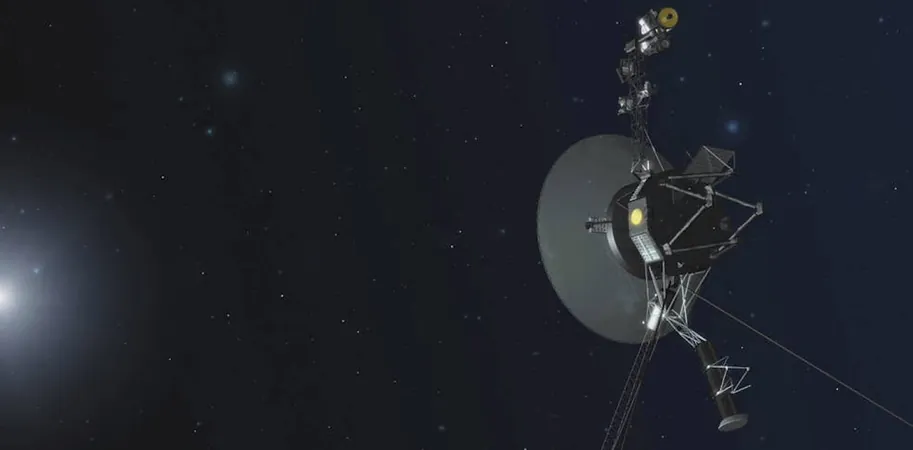
Unveiling the Secrets of Radioisotope Generators: The 'Nuclear Batteries' That Power Space Explorations
2025-03-14
Author: Jia
When we think of powering spacecraft, solar energy often comes to mind, particularly given its ubiquitous presence in our environment on Earth. Many near-Earth missions, like lunar landers and Mars rovers, utilize expansive solar panels to capture sunlight and generate electricity for essential systems and scientific instruments. However, as we venture farther into the harsh vacuum of space, the intensity of sunlight diminishes significantly, rendering solar panels less effective.
This challenge underscores a critical lesson in aerospace engineering: space is a profoundly unforgiving environment. Intense solar flares, extreme temperature fluctuations—ranging from -270 degrees Fahrenheit to over 500 degrees Fahrenheit—and high levels of radiation are just a few of the harsh realities spacecraft must endure. To combat such challenges and to enable exploration of deep space, engineers have devised innovative power solutions, one of which involves technology developed as far back as the 1960s: radioisotope thermoelectric generators (RTGs).
What exactly are RTGs? Think of them as nuclear-powered batteries, capable of supplying energy for decades—even hundreds of millions or billions of miles away from Earth! Unlike traditional batteries that depend on chemical reactions, RTGs generate electricity through the radioactive decay of elements, primarily using plutonium-238.
Plutonium-238 is fundamentally different from the fissile materials used in nuclear reactors. When it undergoes radioactive decay, it emits alpha particles, releasing substantial heat that can be transformed into electricity. This process is reminiscent of nuclear power plants but operates on a unique principle: the decay of plutonium-238 does not require a sustained fission reaction and offers a steady output of energy over an extended period.
This energy conversion hinges on the Seebeck effect, discovered in the early 19th century by German physicist Thomas Seebeck. The principle states that when two different conductive materials are joined and exposed to a temperature differential, they produce an electric current. In the case of RTGs, the heat generated from plutonium-238 decay creates a stark temperature contrast between its core and the frigid conditions of space, enabling the generation of electricity using thermocouples.
The design of an RTG involves safely encapsulating plutonium-238 within an inert material, typically in the form of a solid ceramic. This core is surrounded by insulation and a system of thermocouples, all encased in robust aluminum shielding designed to withstand extreme conditions. The inside of the generator reaches temperatures near 1,000 degrees Fahrenheit, while the exterior can dip to hundreds of degrees below zero, capitalizing on this drastic temperature gradient to produce electricity reliably.
Although RTGs generate a modest output of only a few hundred watts—enough to power a laptop but insufficient for more demanding technology—it's precisely what deep-space missions require. Their most significant advantages lie in their durability and reliability. The decay of radioactive material is constant over time, allowing RTGs to function without the need for moving parts, thereby minimizing the risk of mechanical failure.
Throughout the history of space exploration, RTGs have been crucial for NASA's success with missions targeting both our solar system and beyond. Notably, the Mars rovers, including Curiosity and Perseverance, as well as the iconic New Horizons spacecraft that visited Pluto, all employ RTGs as their primary power source.
The Voyager missions, launched in 1977, perhaps exemplify the longevity and reliability of RTGs more than any other missions. Equipped with three RTGs each, Voyager 1 and 2 continue to transmit valuable scientific data nearly five decades after their launch, operating over 15 billion and 13 billion miles from Earth respectively. They stand as the farthest human-made objects in existence, highlighting the incredible potential and resilience of radioisotope power.
As we look to the future of space exploration, RTGs remain an indispensable technology, driving missions into the uncharted territories of our universe. While it may be unfeasible to install one in your home, these innovative devices have illuminated the cosmos, paving the way for unprecedented discoveries beyond our planet.




 Brasil (PT)
Brasil (PT)
 Canada (EN)
Canada (EN)
 Chile (ES)
Chile (ES)
 Česko (CS)
Česko (CS)
 대한민국 (KO)
대한민국 (KO)
 España (ES)
España (ES)
 France (FR)
France (FR)
 Hong Kong (EN)
Hong Kong (EN)
 Italia (IT)
Italia (IT)
 日本 (JA)
日本 (JA)
 Magyarország (HU)
Magyarország (HU)
 Norge (NO)
Norge (NO)
 Polska (PL)
Polska (PL)
 Schweiz (DE)
Schweiz (DE)
 Singapore (EN)
Singapore (EN)
 Sverige (SV)
Sverige (SV)
 Suomi (FI)
Suomi (FI)
 Türkiye (TR)
Türkiye (TR)
 الإمارات العربية المتحدة (AR)
الإمارات العربية المتحدة (AR)